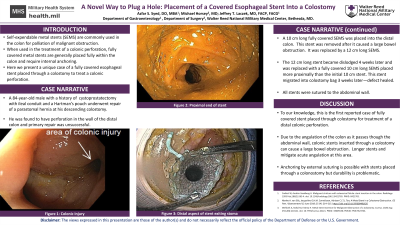Sunday Poster Session
Category: Colon
P0298 - A Novel Way to Plug a Hole: Placement of a Covered Esophageal Stent Into a Colostomy
Sunday, October 22, 2023
3:30 PM - 7:00 PM PT
Location: Exhibit Hall

Has Audio

Azfar S. Syed, DO, MBA
Walter Reed National Military Medical Center
Bethesda, MD
Presenting Author(s)
Azfar S.. Syed, DO, MBA, Michael Horsey, MD, Jeffrey Laczek, MD
Walter Reed National Military Medical Center, Bethesda, MD
Introduction: Self-expendable metal stents (SEMS) are commonly used in the colon for palliation of an obstructing malignancy and, less commonly, used as a bridge to surgery. Due to tissue ingrowth into uncovered stents, fully covered SEMS are used when the stent is intended to be removed. Covered colonic stents are not approved for use in the United States, but fully covered esophageal stents can be used in the distal colon. We present a novel use of a covered SEMS into a colostomy to treat a colonic perforation.
Case Description/Methods: An 84-year-old male with a complicated surgical history to include a cystoprostatectomy with ileal conduit formation due to bladder cancer and a Hartman’s procedure for a sigmoid cancer underwent repair of a parastomal hernia at his descending colostomy. Post-operatively, he developed a hematoma and infection at his surgical site prompting repeat surgical intervention, at which time a perforation of the wall of the distal colon was noted. The perforation was just proximal to the colostomy and primary repair failed due to the viability of the tissue in this area. A fully covered 10cm x 20/25mm SEMS was placed into the distal colon and anchored to the surrounding skin with the 2 cm distal flange of the stent external to the colostomy. Symptoms of bowel obstruction developed within the first 48 hours prompting removal. A longer SEMS (12cm x 23/28mm) was then placed and anchored with the distal end of the skin flush with the abdominal wall. Repeat endoscopy immediately after stent placement confirmed patency of the colonic lumen. The patient’s bowel function has remained normal and surgical site is healing appropriately. Stent removal is planned 8 to 12 weeks following placement.
Discussion: Metal stent placement for distal colonic obstruction in patients with a colostomy has been previously reported, but to our knowledge this is the first report of a fully covered metal stent being placed through a colostomy to cover a perforation in the distal colon. Placement of a metal stent in this location presents several unique issues, one of which is the risk of large bowel obstruction; the colon essentially makes a right angle as it leaves the peritoneum and traverses the abdominal wall and the stent must be of adequate length to extend past this angulation. Additionally, fully covered metal stent should be anchored to prevent migration; when placed through a colostomy, these stents can be easily anchored by suturing them to the skin surrounding the ostomy.
Disclosures:
Azfar S.. Syed, DO, MBA, Michael Horsey, MD, Jeffrey Laczek, MD. P0298 - A Novel Way to Plug a Hole: Placement of a Covered Esophageal Stent Into a Colostomy, ACG 2023 Annual Scientific Meeting Abstracts. Vancouver, BC, Canada: American College of Gastroenterology.
Walter Reed National Military Medical Center, Bethesda, MD
Introduction: Self-expendable metal stents (SEMS) are commonly used in the colon for palliation of an obstructing malignancy and, less commonly, used as a bridge to surgery. Due to tissue ingrowth into uncovered stents, fully covered SEMS are used when the stent is intended to be removed. Covered colonic stents are not approved for use in the United States, but fully covered esophageal stents can be used in the distal colon. We present a novel use of a covered SEMS into a colostomy to treat a colonic perforation.
Case Description/Methods: An 84-year-old male with a complicated surgical history to include a cystoprostatectomy with ileal conduit formation due to bladder cancer and a Hartman’s procedure for a sigmoid cancer underwent repair of a parastomal hernia at his descending colostomy. Post-operatively, he developed a hematoma and infection at his surgical site prompting repeat surgical intervention, at which time a perforation of the wall of the distal colon was noted. The perforation was just proximal to the colostomy and primary repair failed due to the viability of the tissue in this area. A fully covered 10cm x 20/25mm SEMS was placed into the distal colon and anchored to the surrounding skin with the 2 cm distal flange of the stent external to the colostomy. Symptoms of bowel obstruction developed within the first 48 hours prompting removal. A longer SEMS (12cm x 23/28mm) was then placed and anchored with the distal end of the skin flush with the abdominal wall. Repeat endoscopy immediately after stent placement confirmed patency of the colonic lumen. The patient’s bowel function has remained normal and surgical site is healing appropriately. Stent removal is planned 8 to 12 weeks following placement.
Discussion: Metal stent placement for distal colonic obstruction in patients with a colostomy has been previously reported, but to our knowledge this is the first report of a fully covered metal stent being placed through a colostomy to cover a perforation in the distal colon. Placement of a metal stent in this location presents several unique issues, one of which is the risk of large bowel obstruction; the colon essentially makes a right angle as it leaves the peritoneum and traverses the abdominal wall and the stent must be of adequate length to extend past this angulation. Additionally, fully covered metal stent should be anchored to prevent migration; when placed through a colostomy, these stents can be easily anchored by suturing them to the skin surrounding the ostomy.
Disclosures:
Azfar Syed indicated no relevant financial relationships.
Michael Horsey indicated no relevant financial relationships.
Jeffrey Laczek indicated no relevant financial relationships.
Azfar S.. Syed, DO, MBA, Michael Horsey, MD, Jeffrey Laczek, MD. P0298 - A Novel Way to Plug a Hole: Placement of a Covered Esophageal Stent Into a Colostomy, ACG 2023 Annual Scientific Meeting Abstracts. Vancouver, BC, Canada: American College of Gastroenterology.
